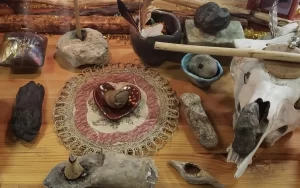The unconscious mind or Shadow is much wiser and has more control over us than we can imagine. Let’s discuss eleven ways to partner with the unconscious for personal evolution and healing. Many people in the modern world ignore or deny the existence of the unconscious, which is reminiscent of the old saying “The greatest trick the devil ever played is convincing us he doesn’t exist.” By denying the existence of the unconscious, it has much more power over us. By building a relationship with this huge and powerful part of our psyche’s, we can really start to heal. The unconscious doesn’t speak the same language as our conscious mind, so we need to develop tools that help us communicate with it. There’s a funny quote by Jung (you can find it on youtube) where he says “The unconscious is hard to understand, because we are unconscious of it.” So here are eleven ways to partner with your unconscious.
- Reeling in our projections. One major way the unconscious mind shows us its content is through projection, which is when we projects unconscious parts of ourselves onto others. Imagine the unconscious is like a film projector, we can only see what is on the film if it is projected outwards onto a screen. Other people become the screen for our unconscious projections. When you feel yourself having a strong, uncontrollable reaction to someone, rather than blaming that person for how you are feeling, slow down and ask yourself what part of your Shadow self are you asking that person to carry? Try and identify what part of you is like the person you are having a strong reaction to? Similarly, we can project our greatest power, that we are unaware of, onto others, usually teachers, guides or gurus. As Marianne Williamson said “Our greatest fear isn’t that we’re weak, our greatest fear is that we’re powerful beyond measure.” Because often we’re afraid of our power, we project it unconsciously. Once you can identify the part of yourself that you are projecting outwards, you will no longer need to project it, because you own it and it will no longer have so much unconscious power over you because you are aware of that part of yourself.
- Projective identification: This is when someone projects onto us and we start acting out their projection. Sounds crazy, but it happens all the time and it means we’re not partnering with our unconscious, but being ruled by it. You need to develop an awareness of when someone is projecting onto you. As much as we project our shadow onto others, others project theirs onto us. If we are not aware of this, we can find ourselves internalizing and unconsciously behaving according to these projected qualities. We may not understand what is happening and ask ourselves, “Why did I do that? Why did I react in that way?” For example, a couple who work together employ a younger person who had difficulties with their own parents and all his life felt stuck in the middle between them. The new employee feels and projects these feelings about his parents onto the couple. After a while, the couple begin to react and behave around the employee in a way that is unfamiliar to them. They are being changed by the projection of the employee. They are living out the shadow projection of the employee’s difficult relationship with his parents. The employee then reacts like a child and blames the employers for his childlike reactions, when in fact he was unconsciously projecting these intolerable feelings onto the situation. The employers need to identify where they were identifying with this projection and the employee needs to reel in his projection and realize the employers are not his parents.
- Journaling and Automatic Writing: Writing in a free-flowing way is a great method for communicating and partnering with our unconscious, instead of projecting. Imagine the pen is not connected to the conscious mind at all but is moving according to the Shadow. Do not think, filter, edit, re-read, while writing. Just allow the words to flow. At the beginning it may feel that what you are writing makes no sense – do not worry about this, just keep writing. Eventually, unconscious material will begin to come through. Again, do not think about it or filter it, just allow it to come through like a river or a stream of consciousness. Partner with your unconscious, don’t be afraid. One way of doing this is setting a timer and writing automatically for ten or fifteen minutes. As you practice this, you will be surprised at what comes up from the shadow that you were unaware of. Read more about journaling in this blog post.
- Collage: Collage can be a very powerful tool for partnering with the unconscious. It is important not to try and mentally control the collage or think about it. Allow yourself to drop into your feelings and as you go through a pile of magazines or images from other sources and rip out the ones that you feel something about. Make a pile of images in this way. Secondly, in the same way as you felt which images to select, feel which ones want to go where on your paper. Feel, don’t think. Once the collage is completed, then it is time to look at the whole thing that has come out of your shadow and not your consciousness and look at what it’s telling you. Maybe turn it upside down. Hang it up and look at it repeatedly for a while. It may take a while for you to recognize the symbolism and connections in a collage. I have found that some collages continue to give me messages from my unconscious for many years after their completion.
- Dreaming: Dreams are one of the most powerful ways of working with the unconscious. If you are working through an issue, you can ask for a dream before going to sleep – often you will receive one. Always have a pen and notepad by the bed so you can jot down the dream as soon as you wake up. Right when you wake up, you may think you will remember it later, but in most cases we don’t, so get into the habit of writing it down right away, even if you wake up in the middle of the night. When we do write down and work with our dreams, the unconscious feels that we are starting to pay attention and will continue to bring you more dreams and more powerful dreams. When working with the symbolism of your dreams, remember that dreams are alive and can have many different and opposing meanings. These meanings can also change with time. Like collages, dreams can be worked on for years and their meanings can evolve over time. Here are some ways to work with dreams to see what is going on in the unconscious mind: a) Look at the setting – is it modern or old, past or present – this could help you see of the dream is speaking about something that is going on in the present or maybe has an ancestral quality to it for example. b) Is the setting in your home or a familiar place or is it in a collective space such as a conference setting, a hotel, a school? These things could help you decide if the dream is personal or has a collective meaning. c) Look at each character in the dream as an aspect of your shadow self. Characters of the opposite sex can help us identify and work with aspects of our animus or anima (inner masculine or inner feminine) Please see this blog post to understand that inner masculine and inner feminine are not gender related. d) Ask yourself how you feel about each symbol, person, animal, setting, action in the dream – try again not to think it but feel into it. What do these symbols mean to you?
- Bodywork: A good bodyworker who understands that we hold unconscious traumas and wounds in our physical bodies will be able to help you liberate these cellular memories. The body is seen as a window for unconscious psychological material. Emotions and unconscious beliefs from this lifetime and beyond can be liberated and integrated through bodywork.
- Ancestral work: Much of what we hold in our unconscious selves does not stem from this lifetime alone. Ancestral work, which includes looking for patterns, unintegrated traumas in people lineages, inherited beliefs, ways of being and reacting can liberate stuck unconscious patterns and feelings. Ancestral work is very powerful and does not only release the person doing the work from unconscious patterns that are holding them back but the healing ripples backwards to those ancestors still trapped in outdates systems of trauma and wounding as well as freeing descendants from having to take these on too. Read more about our ancestral healing work in this blog post and in another blog post.
- Aromas: Essential oils have been used for thousands of years for spiritual and religious ceremonies. Their aromas are not filtered by the thalamus like our other senses – they go straight to the limbic brain where they trigger ancient memories, feelings and emotions. Aromatic molecules touch us at the smallest material level, the closest distance. I touch and I am touched. In our work with people with addiction, we have learnt that what underlies most addiction is psychological trauma. This includes not just abuse but neglect, not just personal but collective, not just the experiencer but historical/inherited/epigenetic trauma. Find out more in this blog post.
- Plant Spirit Medicine: A number of traditional indigenous societies, in almost all parts of the world, work with plant spirit medicines, which seems a more holistic and respectful term, for soul healing. (The only indigenous traditional society that doesn’t use plant spirit medicines or psychedelic plants are the Intuit, which some speculate is due to the lack of psychoactive plants growing near the Arctic.) Psychedelic plant medicine is used to access the unconscious mind helping the person to clear and integrate blockages and traumas that are stopping them being the best version of themselves. Read more about it in this blog post.
- Group Work: The power of group work is huge. A solid, well formed group where there is a feeling of safety and trust with participants that are ready and willing to work on their shadow selves is one of the most powerful resources for inner shadow work. Each member of the group brings their experience and of course their shadow selves to the group. An understanding that depending on the theme, a person in the group who is most affected by that particular theme will be the ‘tent pole’ for the rest of the group is important. This enables every member of the group to be affected by and have a chance to integrate the work of the theme that has come up. Being held by a powerful, willing and trustful group with competent facilitators who are willing to do their own inner work cam move participants forward extremely quickly. We will be our Aromatic Shamanism mentorship, which has been a profound group process, again in 2022
- Working with a therapist who really understands the unconscious: There are as many types of therapy out there as there are people. If you want to work with the unconscious, it is important to choose a therapist who honors the unconscious as the wise and powerful part of the psyche that it is and who is comfortable with their own shadow self. A therapist can only hold space to the extent of to which they have held space for and integrated their won shadow material.
If you are interested in the work we do in groups and individually, you can find more information here.
share this blog:
Recent Posts
Archives
- December 2023
- November 2023
- September 2022
- July 2022
- September 2021
- August 2021
- July 2021
- June 2021
- April 2021
- March 2021
- February 2021
- January 2021
- November 2020
- October 2020
- August 2020
- July 2020
- June 2020
- May 2020
- April 2020
- March 2020
- February 2020
- October 2019
- September 2019
- July 2019
- May 2019
- March 2019
- September 2018





